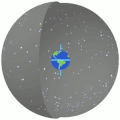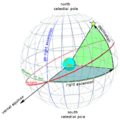Right ascension
Right ascension (abbreviated RA; symbol α) is the astronomical word for one of the two coordinates of a point on the celestial sphere when using the equatorial coordinate system. It is the celestial counterpart to longitude. The other coordinate is the declination.
The moon, planets and stars all have their own right ascension. Many of them are listed in an almanac. Using arithmetic, the object’s right ascension and declination indicate where to look in the sky to see the object.
Right Ascension Media
Right ascension and declination as seen on the inside of the celestial sphere. The primary direction of the system is the March equinox, the ascending node of the ecliptic (red) on the celestial equator (blue). Right ascension is measured eastward up to 24h along the celestial equator from the primary direction.
Right ascension (blue) and declination (green) as seen from outside the celestial sphere
The entire sky, divided into two halves. Right ascension (blue) begins at the March equinox (at right, at the intersection of the ecliptic (red) and the equator (green)) and increases eastward (towards the left). The lines of right ascension (blue) from pole to pole divide the sky into 24 hours, each equivalent to 15°.


